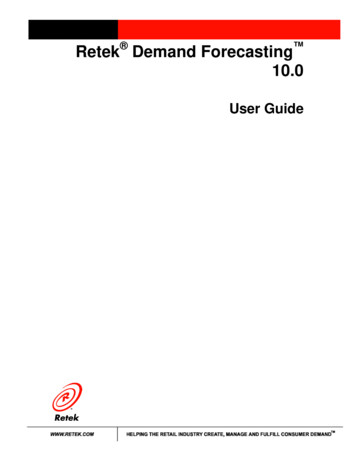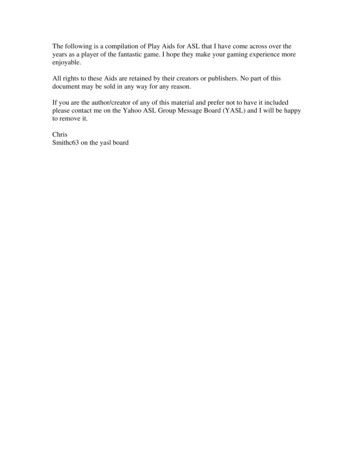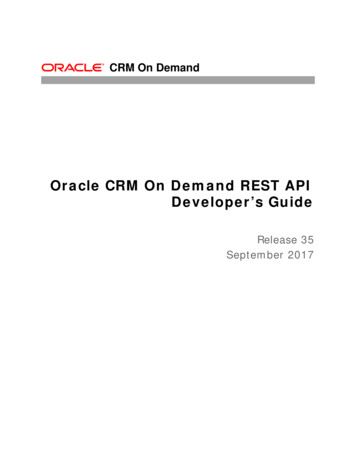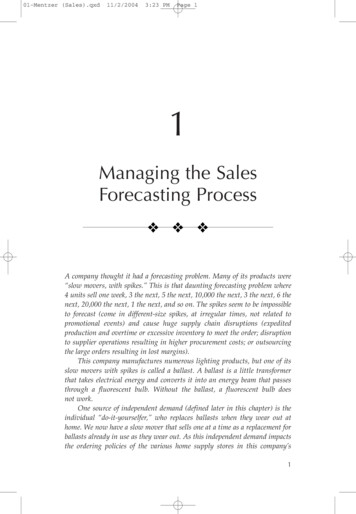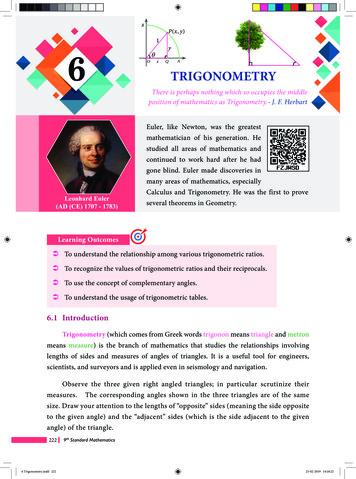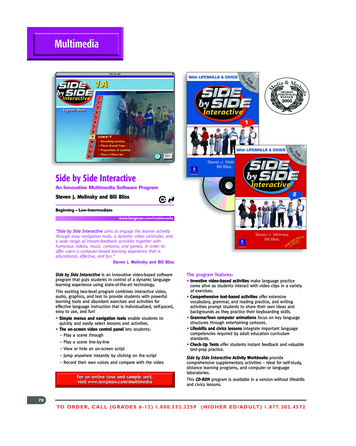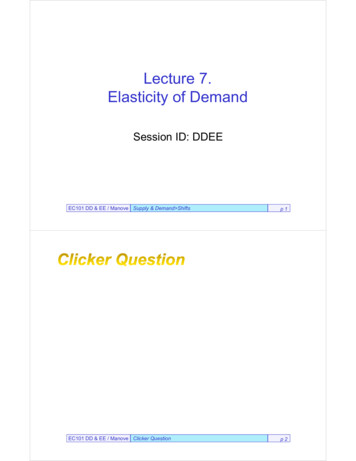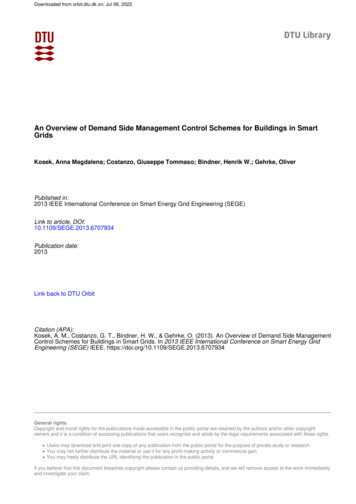
Transcription
Downloaded from orbit.dtu.dk on: Jul 06, 2022An Overview of Demand Side Management Control Schemes for Buildings in SmartGridsKosek, Anna Magdalena; Costanzo, Giuseppe Tommaso; Bindner, Henrik W.; Gehrke, OliverPublished in:2013 IEEE International Conference on Smart Energy Grid Engineering (SEGE)Link to article, DOI:10.1109/SEGE.2013.6707934Publication date:2013Link back to DTU OrbitCitation (APA):Kosek, A. M., Costanzo, G. T., Bindner, H. W., & Gehrke, O. (2013). An Overview of Demand Side ManagementControl Schemes for Buildings in Smart Grids. In 2013 IEEE International Conference on Smart Energy GridEngineering (SEGE) IEEE. https://doi.org/10.1109/SEGE.2013.6707934General rightsCopyright and moral rights for the publications made accessible in the public portal are retained by the authors and/or other copyrightowners and it is a condition of accessing publications that users recognise and abide by the legal requirements associated with these rights. Users may download and print one copy of any publication from the public portal for the purpose of private study or research. You may not further distribute the material or use it for any profit-making activity or commercial gain You may freely distribute the URL identifying the publication in the public portalIf you believe that this document breaches copyright please contact us providing details, and we will remove access to the work immediatelyand investigate your claim.
An Overview of Demand Side Management ControlSchemes for Buildings in Smart GridsAnna Magdalena Kosek , Giuseppe Tommaso Costanzo , Henrik W. Bindner and Oliver Gehrke TechnicalUniversity of Denmark, Department of Electrical EngineeringEnergy System Operation and ManagementEmail: {amko,guco,hwbi,olge}@elektro.dtu.dkAbstract—The increasing share of distributed energy resourcesand renewable energy in power systems results in a highlyvariable and less controllable energy production. Therefore, inorder to ensure stability and to reduce the infrastructure andoperation cost of the power grid, flexible and controllable demandis needed. The research area of demand side management is stillvery much in flux and several options are being presented whichcan all be used to manage loads in order to achieve a flexibleand more responsive demand. These different control schemesare developed with different organization of the power sectorin mind and thus can differ significantly in their architecture,their integration into the various markets, their integration intodistribution network operation and several other aspects. Thispaper proposes a classification of load control policies for demandside management in smart buildings, based on external behavior:direct, indirect, transactional and autonomous control; internaloperation: decision support system scope, control strategy, failurehandling and architecture. This classification assists in providingan overview of the control schemes as well as different ways ofrepresenting a building.I.I NTRODUCTIONIn most of today’s power systems, nuclear, hydro and fossilpower plants provide the majority of energy production [1],[2], while peak consumption is matched by regulation plantsand power exchange between grids. However, in the last twodecades factors such as the increased global energy demand,speculation on fossil fuels, and global warming have generateda high interest in Renewable Energy Resources (RES) andElectric Vehicles (EVs). For example, in Denmark the windpower is planned to supply approximately 50% of the demandby the year 2020 [3]. In this context, power systems willhave to face challenges such as accommodating a highlyvariable and less controllable distributed energy production,and reducing the peak demand. In order to avoid or delaylarge investments in grid infrastructures and storage facilities,already existing consumption units can be enabled with controlcapabilities. Demand Side Management (DSM) is a promisingtechnology for power balancing in future energy systems.A classification of control policies for DSM focusingon smart buildings, presented in this paper, can help withthe selection of a DSM controller for a specific application,provide comparison criteria between technologies, and help inthe standardization process.2WBCSD estimates that in most countries buildings account approximately for the 30-40% of total energy consumption [4], therefore controlling buildings with Home Automa2 TheWorld Business Council for Sustainable Developmenttion Systems (HAS) with remote control can enhance overalldemand flexibility. It is assumed, in this context, that a smartbuilding is equipped with controllable appliances and smartdevices in order to enable flexible consumption. As manyresearch projects have investigated different approaches toDSM in smart buildings, this paper presents an overview ofselected DSM systems and proposes a classification for controlschemes for Distributed Energy Resources (DERs).This paper is organized as follows: in Section II controlpolicies are classified depending on external behavior. Thissection presents general DSM control policies not only forbuildings, but any DER present in the Distribution Grid. InSection III control policies are classified by internal operationof the HAS, and in Section IV building representation is described. Section V presents an overview of selected DSM andHAS systems and describes how the proposed classificationcan be applied to some of the related control policies. DERControl comparison criteria and useful simulation tool areintroduced in section VI. Conclusions and future work areoutlined in Section VII.II.E XTERNAL BEHAVIORIndependently of the reference architecture chosen for thefuture Smart Grid, different types of interactions betweenactors can be proposed and DER control policies defined. Theexternal behavior characterizes the interactions of DER withother entities in the architecture, such as other controllers,utilities or energy traders in terms of communication type andinformation aldecisionmakingtransactionalcontroldirect controlnocommunicationFig. icationDER control matrix for demand side management.The classification based on external behavior contains possible mechanisms within DER of reacting on signals receivedform other actors in the Smart Grid. In the Demand SideManagement domain control policies are usually divided intodirect and indirect, for example as proposed in [5] and [6]. Inthis paper a DSM control policies classification is presented
proposing four categories: autonomous, direct, indirect andtransactional control. Figure 1 depicts a proposed classification mapped onto communication type and the location ofthe decision making process. Direct control uses an externalcontroller with a central decision making process to determineDER operation, where in case of autonomous, indirect andtransaction control policies the DER is responsible for localdecisions.P [W]P [W](A)t [s](B)Direct control is a technique based on issuing specificcommands to controllable DERs. The decision on DER operation is taken by an external controller that embeds the mainintelligence and has a knowledge of the DER status. In thedirect control scheme an external controller has specific anddetailed information about the DER operation.A direct controller uses two-way or one-way unicast communication to exchange information with a DER . In case ofone-way communication a DER is obliged to follow controlcommands. The only deviation from expected behavior canoccur due to operational limit violation or failures. In case ofbidirectional communication each DER is obliged to acknowledge the received command. A DER informs the external controller whether the control command can be executed or not,and provides the controller with the DER status. Commandssent by the external controller may vary depending on the DERtype and communication protocol.Gehrke et. al [7] presented direct load control schemes,depending on the information type exchanged between thecontroller and a DER: deferred consumption, delta consumption, scheduled operation and direct power control. Loadcontrol schemes can be extended to cover both consumptionand production, therefore DER operation control schemes aredefined as follows:1) Deferred operation: The consumption or production ofa certain amount of energy is shifted in time, as presentedin Figure 2(A). Neither the amount of consumed or producedpower, nor duration of the operation is modified. The signalthat is received by the DER is of type t, which represents arequired delay of operation.2) Delta operation: The amount of energy consumed orproduced by the controlled DER is decreased or increased byan offset of P , called power difference, see Figure 2(B).Decrease in consumption might result in increase in durationof the operation, for example in operation of thermal loads likea heat-pump.3) Scheduled operation: The DER is provided with anoperation schedule s, consisting of time series of power setpoints and time stamps, where s {(ti , Pi )}, i N, as shownin Figure 2(C).4) Direct power control: At run-time the DER is providedwith a power set point, P , as depicted in in Figure 2(D).Each DER is equipped with a local controller for lowlevel hardware control, which is responsible for performingthe necessary actions in order to meet the requirements setby the external controller. A direct controller, by using anoptimized mix of the direct control schemes presented above,t [s]t [s]P [W]P [W]A. Direct Controlt [s]P [W]P [W](C)t [s]t [s]P [W]P [W](D)t [s]t [s]Fig. 2. Operation schemes for DER direct control: (A) Deferred operation,(B) Delta operation, (C) Scheduled operation, (D) Direct power control.can operate units in order to provide such services as: voltageand frequency regulation, load shedding, valley filling. In thecontrol-by-services scheme high level commands are issuedto a DER to control a previously defined service. In this typeof direct control a DER service, for example a voltage control,is decoupled from a DER type, for example a wind turbine [8].B. Indirect ControlIn a power system context, indirect control is a way ofmanaging a DER by issuing signals which might or mightnot affect its operation. Heussen et. al. in [6] define twocharacteristics of the indirect control: ”indirectness of therelationship between control objective and observables”, and”local and independent decision making of the DER makesits behavior non-deterministic”. The DER accepts the controlsignals but it is not obliged to either react to the signal orsend any feedback. Lack of the feedback implies that indirectcontrol requires only one-way communication to transfer thecontrol signal from external controller to a DER. Indirectcontrol can uses broadcast to propagate messages, any DERcan simply choose to listen to commands at any time.Scalability, as defined by Tanenbaum [9], is a characteristicof a system that remains effective when there is a significantincrease in number of resources or users. Broadcast signalspropagated in the indirect control scheme can be receivedby any number of units, in contrast to single addressing inunicast communication in the direct control scheme. Scalabilityof the indirect control makes it suitable for systems withhigh uncertainty in DER number, type and external influencefactors, for example power systems with changing topology.The indirect control advantages are simplified protocols,exchanged data and interfaces. DERs can follow thair privateand dynamic objectives and prioritize local goals. In comparison to direct control, predictability of the DER responseis lower, due to its non-deterministic behavior. To reducemismatch between control objective and the actual response,DER models including relationship between signal and theresponse are needed [6]. If the field measurements of the power
consumption are available, it is possible to infer reaction of aDER by the impact they have on the grid.Heussen et.al. [6] classifie indirect control into four categories: control with indirect functional variables, independentlocal control, indirect control via price signals and controlwith internal market platform. In this paper independent localcontrol (called here autonomous control) and control withinternal market platform (called here transactional control) areseparated from indirect control as depicted in Figure 1 anddescribed in section II-D. Indirect control, following [6], isdivided into two categories:1) Control with indirect functional variables: A controlscheme in which a signal containing a functional variable issent from an external controller to a DER in order to influencethe DER operation. An example of a functional variable can bea local set-point thermostat temperature in a heating system.The external controller objective is to modify heating systempower consumption without knowledge of heaters state. Sincethe state is unknown and there is no control feedback, thesystem response is non-deterministic. Observable or estimatedaggregated response, for example the heating system powerconsumption, can be used to generate the functional variablesignal. Statistical models can be used to reduce the mismatchbetween the control objective and the system response.2) Indirect control via price signals: A control schemebased on issuing energy prices to DERs in order to alternateits operation. Indirect control via price signals is furtherdivided into instantaneous price operation and scheduled priceoperation. In the instantaneous price operation scheme thecontrol signal consists of a single price p and time stampsignal that states the time when the price becomes valid. In thescheduled price operation, the signal is a schedule s of futureprices, consisting of time series of prices and time stamps ,where s {(ti , pi )}, i N.In this way each single unit can participate in frequencyor voltage regulation independently. Due to the use of localmeasurements, this kind of control is characterized by a fastresponse and it does not need a communication infrastructureor higher-level control entities. While such DER does not needany supervision, and works autonomously, it can provide avaluable local power system service.In this section, the external behavior of the controller wascharacterized by direct, indirect, transactional and autonomouscontrol mechanisms. Another characteristic on which it is possible to classify control policies is the internal DER operation,which is described in the following section. This classificationfocuses on a particular type of DER, a controllable building. Inthe context of the power system a smart building is referred toa controllable building capable of accepting commands fromexternal controllers, managing and supervising the operationof all internal subsystems.III.The internal operation of a controller in a building regardsall the inner actions taken by the controller and it can becharacterized by the scope of the decision support system,control strategy, failure handling and architecture.A. Decision support system scopeDepending on the information a controller is provided with,it can operate on the basis of different techniques. In thedomain of Demand Side Management three types of decisionsupport system can be recognized based on the controllerdecision scope: past, present and future (Fig. 3).KnowledgeinterpretationC. Transactional controlTransactional control, called also market-based control[10], or control with internal market platform [6] refers to acontrol strategy based on negotiations in a bid-based market.In transactional control DERs are competing for one or moreresources on an equilibrium market with the use of bids.After the end of the the transaction DERs can optimize theirproduction or consumption with use of the equilibrium valuedetermined by the market. The main goal of the transactionalcontrol is to distribute resources efficiently by taking intoaccount correlated needs of different DERs [11]. A DER independently decides about the bidding amount and autonomouslyplan the control accordingly to the winning bid.Price-based transactional control combines the price negotiation features with local biding strategy, resulting in resourceallocation based on individual DER needs without revealingits operation strategy. The decisions about DER operation andoffered bids are taken locally, the market is constructed to finda price equilibrium for participating DERs.D. Autonomous controlDER controllers can be designed to take decisions basedon local signals, such as frequency or voltage measurements.I NTERNAL OPERATIONPatternrecognitionPastFig. ecision support system scopes.1) Knowledge interpretation: The general knowledge abouta specific domain is interpreted to support decision makingmechanism. Knowledge can be fixed or learned form thehistorical data.2) Pattern recognition: A decision is based on historicaldata by performing pattern recognition. Historical data maybe both gathered at runtime, during device operation, orprovided as a calibration set by the manufacturer. Historicaldata can also be used to track users behavior patterns, devicesconsumption models or to relate power consumption to timeof day or day of week.3) Online adaptation: Online adaptation is based on logicthat uses information gathered at run-time to adapt to changingconditions and does not take into account the control actionstaken previously.4) Predictive control: A prediction of users behavior ordevices power consumption is used for optimal scheduling ofhouse power consumption. This prediction can be based onavailable models, historical data or both. Information provided
by other entities, such as weather forecast source, can be usedto plan unit operation to fit changing environmental conditions.Intelligent controllers can combine presented scopes anduse historical, live data and forecasts in their decision supportsystem. For example a DER consumption model can becreated from historical data and general domain knowledgeand updated with live data. This model can be then usedtogether with weather forecasts to produce a DER consumptionprediction.B. Control strategyIn the run-time a controller may be flexible toward a changeof its control strategy. The control strategy can be classifiedas static, flexible and re-configurable. Static controllers workwith a defined control strategy that is not changed, whileflexible controllers implement several control strategies thatcan be switched during the unit operation on the basis of localmeasurements or third party information provided by externalcontrollers. On the other hand, reconfigurable controllers aredesigned to modify the internal logic based on external influences. Advanced reconfigurable controllers can implementmachine learning, defined as ability of computer systems toautomatically improve with experience [12]. Although the controllers belonging to this latter class offer great flexibility, theirbehavior is subject to a continuous tuning process, therefore itmight be difficult to predict.C. Failure handlingResilience, defined by Rieger [13], is an ability of a controlsystem to remain effective despite of disturbances, assuringsafe and secure operation of the controlled components. In thecontext of the power system, the ability to sustain grid servicesis connected to failure handling: detection, diagnosis, maskingand tolerating. Faults can include hardware and software faults,for example fail-stop, crash or omission (including connectionfailures). In this section control schemes for failure handlingare divided into two categories: mask or tolerate.1) Mask failures: Failures that are detected can be hiddenor made less critical. Software controllers using techniques tomask failures can try to reconnect to other software components, for example a database, switch to another source of data,for example search for the nearest weather station.2) Tolerate failures: A controller implements failure toleration if it continues to work even if part of the external systemor internal modules have failed. Some of the software modulesof the controller can fail: communication interface, data logger,external data might not arrive when expected or databases canrefuse the connection. A controller that tolerates failures canperform gentle degradation. In the case of severe faults in theexternal system, controller can switch to a simple autonomouscontrol or apply default settings.In the context of power system, the external controllability of a DER that implements failure masking or tolerancedepends on the type of failure handling that was chosen forthe controller architecture. DERs, whose operation is basedon continuous information retrieval, such as price signals inindirect control or power set points in direct control scheme,get affected in their operation in case of failure of connection. In this case, the DER controller may switch to otheroptimization objectives, like maximization of user comfort orfollowing a flexible behavior pattern. Therefore the DER isno longer offering services to the grid. A control policy canalso be unaffected by faults when a DER performs a servicethat is independent of continuous communication with externalcontrollers. For example, direct control with a schedule allowsDERs to operate, once received the operation schedule, untilthe scheduled instructions finish without receiving any furtherinformation. Also DERs controlled with local signals cancontinue operating, since local measurements are independentof the communication with an external controller.D. ArchitectureThe internal architecture of a controller managing a DERcan be centralized, decentralized, distributed or hierarchical.1) Centralized architecture: In the case of a centralizedarchitecture, the central component has a complete view ofthe system and takes decisions regarding units operation. Alldecisions need to be made in the central component. Centralized software architecture brings advantages of concentratingthe controller’s functions in a single component, that is ableto perform system level optimization, it is also able to judgesystem state and harmonize all performed actions. On the otherhand the central component is both a single point of failureand might introduce the bottleneck of the system, thereforecentralized architecture should be designed carefully.2) Decentralized architecture: In the decentralized architecture, a control task is taken away from the central controller, decomposed into sub-tasks and delegated to differentsubsystems [14]. In the decentralized architecture there are nocouplings between subsystems, their operation is autonomous.3) Distributed architecture: In the case of distributed software architecture, subsystems take local decisions based oninformation exchange with other subsystems [14]. In thisarchitecture subsystems might have the same or different andpossibly conflicting goals [15]. Consensus can be reachedby a negotiation process. Such a scheme allows cooperation,resources negotiation and exchange of information.4) Hierarchical architecture: A system has a hierarchicalarchitecture if different layers of abstraction can be distinguished [14]. Levels are introduced to reduce complexity,usually highest layer models system characteristics and lowerlayers represent detailed characteristics.Multi-Agent Systems (MAS) is a very popular programming paradigm that allows implementation of all presentedarchitectures. A MAS mostly implements distributed and hierarchical architectures, where responsive agents encapsulatedifferent behavior and follow own goals while cooperating orcompeting with other agents for resources.Optimal, reliable and flexible solutions can be achievedusing any controller software architecture, and the choicedepends on the application and system requirements. As it hasbeen presented in this section, control policies can be classifiedby their internal operation. Characterization based on decisionsupport system scope, control strategy, failure handling andsoftware architecture were presented.The concept of demand response uses the controllability ofDERs to provide power system services. In order to control
a building, a representation of the building and all devicesconsuming and producing power in it needs to be defined.Section IV presents a proposed building representation and itsimpact on the external building behavior towards other actorsin the power system in direct, indirect and transactional controlpolicies.IV.B UILDING REPRESENTATIONA building may not be viewed a uniform DER, it cana collection of separate subsystems, for example: HVAC,lighting systems, appliances and different devices coexistingin a space, all supplied from the same grid connection. Howa single house is represented in the power system context isimportant for the control strategy. A building can be definedas a single DER or as a collection of systems that are definedas separate DERs as presented in Figure 4.(A)(B)Fig. 4. Building representation the power system for control and aggregation.(A) building represented as a single DER, (B)- building represented as acollection of DERs, HAS - Home Automation System, G - gateway, Iinterface.1) Building represented as a single DER: A building is aconsumer or a prosumer (both consumer and producer) thatcan be controlled externally through an interface to an internalHAS. The HAS communicates with the external controller andoperate devices in the house, as depicted in Figure 4(A). Forthe external controller a house is a controllable single unit.An interface to communicate between external controller andHAS need to be implemented.2) Building represented as a collection of DERs: Thebuilding subsystems are for example heating, ventilation, hotwater, lighting systems, appliances and all devices that arepermanently or temporarily in the house. This list could alsoinclude electric vehicles or any other batteries, production unitslike: microCHP, generators, photovoltaics or wind turbines. Inthis case the gateway only passes the request from a highlevel controller to a DER and all subsystems are controlledindividually. In this type of the building representation, a singleHAS is replaced with a gateway translating from external tointernal communication, as presented in Figure 4(B). In thiscase DERs need to implement an interface and data exchangeprotocols in order to be controlled remotely. These interfacesand protocols can differ form one DER to another, becauseevery subsystem in the building can be controlled using adifferent technology implemented by different vendors.Depending on which of the two building representationsis used the control strategy differs. Following sections presentinfluence of the building representation on direct, indirect andtransactional control.A. Direct controlIf a building is represented as a single DER, it canbe operated directly by an external controller. The HAS isresponsible for dispatching tasks to different units and managing the requested power system service. In this case theexisting HAS communication can be used to control devices.The HAS needs to implement an interface to the externalcontroller and new power management functions responsiblefor providing power system services. Depending on the type ofdirect control, a HAS needs to implement additional features.For all direct control schemes a device operation scheduleis needed. Since only the aggregated operation of the houseis visible to the external controller, a HAS needs to createand update a schedule of operation. In order to properlyschedule devices operation, especially in residential buildings,a HAS needs to recognize user preferences and behavior, andimplement device models. Delta operation and direct powercontrol schemes need on-line adaptation, since requests thatare received concern only instantaneous consumption. Controlsignals received in deferred and scheduled operation schemescontains information about the future operation, thereforeoptimal device operation schedule can be produced.In case of representing a house as a collection of DERs,all subsystems need to be individually controlled. Since manytechnologies can co-exist in one building, either standardizedinterfaces to DER should be used or the external controllerneeds to implement many specific interfaces to DERs. Sincethere is no HAS controlling the total house consumption andproduction, DER aggregated operation needs to be managedat the external controller level.B. Indirect controlFor a building represented as a single DER, a price signalcan be sent to a HAS in order to control it indirectly. In thecase of the instantaneous price operation scheme, a single pricesignal is used to influence the building operation, thereforeHAS needs on-line adaptation and a mechanism to recognizeif the price is low or high, usually based on historical data anduser preferences. In the case of the scheduled price operationscheme, the HAS uses a prices signal to schedule devices’operation or plan the future operation of the entire building.In this case HAS internal communication infrastructure can bereused, because devices does need to receive price signals, butreceive only control signals.If a building is represented as a collection of DERs, theprice signal is passed to individual DERs present in the house.The control decision is taken locally in the DER based onthe received price. The DER need to interpret the price and,depending on the implemented indirect control scheme, adaptonline to the received price or use prediction and receivedfuture energy prices to schedule its own operation. The existingHAS communication in the building can be reused, but thecommunication protocols and DER interface needs to beimplemented to be able to pass the price signal to a DER.C. Transactional controlWith transactional control, a buildi
Gehrke et. al [7] presented direct load control schemes, depending on the information type exchanged between the controller and a DER: deferred consumption, delta consump-tion, scheduled operation and direct power control. Load control schemes can be extended to cover both consumption and production, therefore DER operation control schemes are
